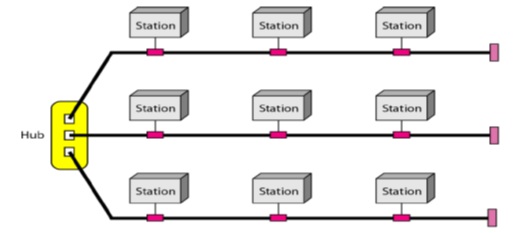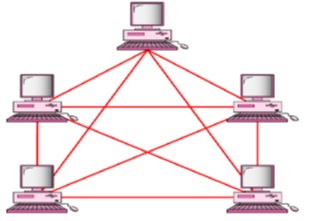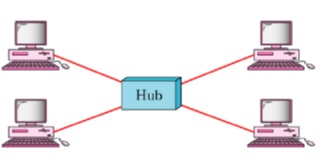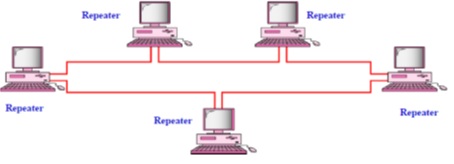Types of Topologies:
The term physical topology refers to the way in which a network is laid out physically.
Two or more devices connect to a link; two or more links form a topology. The topology of a network is the geometric representation of the relationship of all the links and linking devices (usually called nodes) to one another.
There are four basic topologies possible: mesh, star, bus, and ring which are shown in the following figure.
1.Mesh Topology:
In a mesh topology, every device has a dedicated point-to-point link to every other device. The dedicated link carries traffic only between the two devices it connects. The number of physical links needed in a fully connected mesh network with n nodes are, n(n - 1). However, if each physical link allows communication in both directions (duplex mode), we can divide the number of links by 2. In other words, we can say that in a mesh topology, we need n(n -1) /2 duplex-mode links. To accommodate that many links, every device on the network must have n – 1 input/output (I/O) ports to be connected to the other n - 1 stations which are shown in the following figure:
You May Also Like:
Data Communications and Its Characteristics
Characteristics of Networks
Protocols and Standards
Components of Data Communication
Advantages of Mesh Topology:
1. The dedicated links guarantees that each connection can carry its own data load, thus eliminating the traffic problems that can occur when links must be shared by multiple devices.
2. A mesh topology is robust. If one link becomes unusable, it does not incapacitate the entire system.
3. Another advantage of Mesh topology is advantage of privacy or security. When every message travels along a dedicated line, only the intended recipient sees it. Physical boundaries prevent other users from gaining access to messages.
4. point-to-point links make fault identification and fault isolation easy. Traffic can be routed to avoid links with suspected problems. This helps to discover the precise location of the fault and aids in finding its cause and solution.
Disadvantages of Mesh Topology:
1. Every device must be connected to every other device. So large amount of cabling and the number of I/O ports are required. So, the installation and reconnection are difficult.
2. The sheer bulk of the wiring can be greater than the available space (in walls, ceilings, or floors) can accommodate.
3. The hardware required to connect each link (I/O ports and cable) can be prohibitively expensive.
2.Star Topology:
In a star topology, each device has a dedicated point-to-point link only to a central controller, usually called a hub. The devices are not directly linked to one another. Unlike a mesh topology, a star topology does not allow direct traffic between devices. The controller acts as an exchange: If one device wants to send data to another, it sends the data to the controller, which then relays the data to the other connected device as shown in the following Figure.
Advantages of Star Topology:
A star topology is less expensive than a mesh topology. In a star, each device needs only one link and one I/O port to connect it to any number of others.
A star topology is robust. i.e If one link fails, only that link is affected. All other links remain active. This factor also lends itself to easy fault identification and fault isolation.
Disadvantages Star Topology:
1.One big disadvantage of a star topology is the dependency of the whole topology on one single point, the hub. If the hub goes down, the whole system is dead.
2.Although a star requires far less cable than a mesh, each node must be linked to a central hub. For this reason, often more cabling is required in a star than in some other topologies (such as ring or bus).
3.Bus Topology:
The preceding examples all describe point-to-point connections. A bus topology, on the other hand, is multipoint. One long cable acts as a backbone to link all the devices in a network which is shown in the following figure.
Nodes are connected to the bus cable by drop lines and taps. A drop line is a connection running between the device and the main cable. A tap is a connector that either splices into the main cable or punctures the sheathing of a cable to create a contact with the metallic core. As a signal travels along the backbone, some of its energy is transformed into heat. Therefore, it becomes weaker and weaker as it travels farther and farther. For this reason there is a limit on the number of taps a bus can support and on the distance between those taps.
Advantages of Bus Topology:
1. The main advantages of a bus topology is ease of installation. Backbone cable can be laid along the most efficient path, then connected to the nodes by drop lines of various lengths.
Disadvantages of Bus Topology:
1. The disadvantage of bus topology is difficult reconnection and fault isolation. A bus is usually designed to be optimally efficient at installation. It can therefore be difficult to add new devices. Signal reflection at the taps can cause degradation in quality.
2. A fault or break in the bus cable stops all transmission, even between devices on the same side of the problem. The damaged area reflects signals back in the direction of origin, creating noise in both directions.
4. Ring Topology:
In a ring topology, each device has a dedicated point-to-point connection with only the two devices on either side of it. A signal is passed along the ring in one direction, from device to device, until it reaches its destination. Each device in the ring incorporates a repeater. When a device receives a signal intended for another device, its repeater regenerates the bits and passes them along. A typical ring topology is as shown in the figure.
Advantages of Ring Topology:
A ring is relatively easy to install and reconfigure. Each device is linked to only its immediate neighbors (either physically or logically). To add or delete a device requires changing only two connections.
A signal is circulating at all times (token) if one device does not receive a signal within specified period, it can issue an alarm. The alarm alerts the network operator to the problem and its location
Disadvantages of Ring Topology:
The main disadvantage of ring topology is unidirectional traffic can be a disadvantage. In a simple ring, a break in the ring (such as a disabled station) can disable the entire network.
5. Hybrid Topology:
A network can be hybrid. For example, we can have a main star topology with each branch connecting several stations in a bus topology as shown in the following figure.

If one link fails, only that link is affected. All other links remain active. This factor also lends itself to easy fault identification and fault isolation.
You May Also Like:
Different Data Flow Directions
Different Types of Connections
Types of Networks
Back to DCN Questions and Answers





